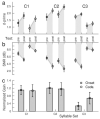Adaptive Syllable Training Improves Phoneme Identification in Older Listeners with and without Hearing Loss
- PMID: 36412658
- PMCID: PMC9680330
- DOI: 10.3390/audiolres12060063
Adaptive Syllable Training Improves Phoneme Identification in Older Listeners with and without Hearing Loss
Abstract
Acoustic-phonetic speech training mitigates confusion between consonants and improves phoneme identification in noise. A novel training paradigm addressed two principles of perceptual learning. First, training benefits are often specific to the trained material; therefore, stimulus variability was reduced by training small sets of phonetically similar consonant-vowel-consonant syllables. Second, the training is most efficient at an optimal difficulty level; accordingly, the noise level was adapted to the participant's competency. Fifty-two adults aged between sixty and ninety years with normal hearing or moderate hearing loss participated in five training sessions within two weeks. Training sets of phonetically similar syllables contained voiced and voiceless stop and fricative consonants, as well as voiced nasals and liquids. Listeners identified consonants at the onset or the coda syllable position by matching the syllables with their orthographic equivalent within a closed set of three alternative symbols. The noise level was adjusted in a staircase procedure. Pre-post-training benefits were quantified as increased accuracy and a decrease in the required signal-to-noise ratio (SNR) and analyzed with regard to the stimulus sets and the participant's hearing abilities. The adaptive training was feasible for older adults with various degrees of hearing loss. Normal-hearing listeners performed with high accuracy at lower SNR after the training. Participants with hearing loss improved consonant accuracy but still required a high SNR. Phoneme identification improved for all stimulus sets. However, syllables within a set required noticeably different SNRs. Most significant gains occurred for voiced and voiceless stop and (af)fricative consonants. The training was beneficial for difficult consonants, but the easiest to identify consonants improved most prominently. The training enabled older listeners with different capabilities to train and improve at an individual 'edge of competence'.
Keywords: adaptive training; aging; auditory rehabilitation; hearing loss; phoneme identification; speech-in-noise perception.
Conflict of interest statement
The authors declare no conflict of interest.
Figures







Similar articles
-
Speech perception in older hearing impaired listeners: benefits of perceptual training.PLoS One. 2015 Mar 2;10(3):e0113965. doi: 10.1371/journal.pone.0113965. eCollection 2015. PLoS One. 2015. PMID: 25730330 Free PMC article.
-
Impact of spectrally asynchronous delays on consonant voicing perception.J Am Acad Audiol. 2010 Sep;21(8):493-511. doi: 10.3766/jaaa.21.8.2. J Am Acad Audiol. 2010. PMID: 21034697
-
Effects of Simulated Hearing Loss on Bilingual Children's Consonant Recognition in Noise.Ear Hear. 2017 Sep/Oct;38(5):e292-e304. doi: 10.1097/AUD.0000000000000428. Ear Hear. 2017. PMID: 28353522 Free PMC article.
-
Phonetics of intervocalic consonant perception: retrospect and prospect.Phonetica. 1995;52(1):1-40. doi: 10.1159/000262027. Phonetica. 1995. PMID: 7862747 Review.
-
Time and language--critical remarks on diagnosis and training methods of temporal-order judgment.Acta Neurobiol Exp (Wars). 2004;64(3):341-8. doi: 10.55782/ane-2004-1518. Acta Neurobiol Exp (Wars). 2004. PMID: 15283477 Review.
Cited by
-
Bursts of vagus nerve stimulation paired with auditory rehabilitation fail to improve speech sound perception in rats with hearing loss.iScience. 2024 Mar 19;27(4):109527. doi: 10.1016/j.isci.2024.109527. eCollection 2024 Apr 19. iScience. 2024. PMID: 38585658 Free PMC article.
-
The impact of visual information in speech perception for individuals with hearing loss: a mini review.Front Psychol. 2024 Sep 24;15:1399084. doi: 10.3389/fpsyg.2024.1399084. eCollection 2024. Front Psychol. 2024. PMID: 39380752 Free PMC article. Review.
References
-
- Bronus K., El Refaie A., Pryce H. Auditory Training and Adult Rehabilitation: A Critical Review of the Evidence. Glob. J. Health Sci. 2011;3:49–63. doi: 10.5539/gjhs.v3n1p49. - DOI
Grants and funding
LinkOut - more resources
Full Text Sources

